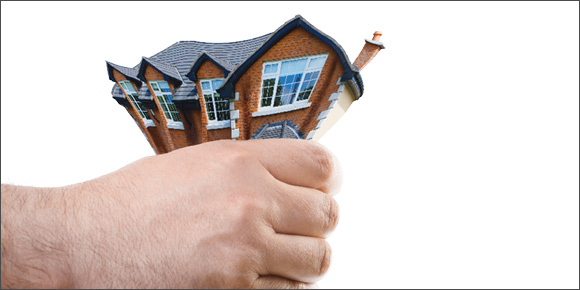Tearing down, building up—what homebuyers do when they can’t find the features they want.
By Daniel Rome Levine
In many parts of the country, a shortage of newer, larger homes and available land to build on is leading some buyers to purchase properties just so they can demolish them and start from scratch.
Teardowns were all the rage in the 1990s and early 2000s as the term McMansions became part of the real estate vernacular. The housing crash put an end to that as many of these luxurious properties turned into foreclosures. Now teardowns are skyrocketing.
Older Houses, Younger Buyers
For each of the last three years, Paul Emrath, vice president of survey and housing policy research at the National Association of Home Builders (NAHB), has asked his members how many of the new homes they built were teardowns. Last year, the answer was 92,000, or nearly 12 percent of all single-family housing starts, up 67 percent from the year before and up 87 percent from the 32,000 teardowns reported in 2014, a figure Emrath says should actually be higher.
Emrath says teardowns are a popular option in places where buildable land is scarce because of geographic or other constraints, such as municipalities where stringent local regulations limit building.
Another factor driving teardowns, he says, is a desire to replace older houses that don’t appeal to today’s younger buyers. “The median age of existing housing units keeps going up,” Emrath says. Indeed, that median age increased to 37 years in 2015, up from 31 years a decade ago. “This housing stock aging trend signals a growing market for remodelers, as older structures normally require additional remodeling and renovations. It also implies a rising demand for new construction over the long run,” according to an NAHB report.
Coral Gundlach, CRS, hardly recognizes her own Arlington, Virginia, neighborhood anymore. Since she moved to the Washington, D.C., suburb 15 years ago, most of the early 1950s single-story ranch, or rambler style, homes that populated the area have been torn down and replaced with much larger, high-end homes with layouts and design features coveted by today’s buyers.
“These new construction homes are changing the whole landscape of the neighborhood and the way streets look,” says Gundlach, an agent with Century 21 Redwood Realty. “And the pace is only picking up.”
Gundlach herself moved into one of these newer homes two years ago and says the neighborhood’s transformation is being driven by a scarcity of buildable land and buyers who want more space and features, such as attached garages, spacious master bathrooms, ample closet space and open family rooms.
“People are living differently than the way they did when these houses were built,” she says. “They just don’t have the floor plan or the features that buyers really want, and people who can afford more, want more.”
Paying Up to Tear Down
In Northern Virginia, Gundlach says, builders are typically purchasing teardown properties for $650,000 to $900,000 and then turning around and selling their new, larger houses for $1.6 million to $2 million.
Individual buyers are also eager to snap up these older properties. Gundlach says she is always on the lookout for potential teardowns that don’t yet have a “for sale” sign in front. When she has a buyer who is interested in one, she sends out a personalized, carefully thought out letter to the homeowner expressing interest in the lot. “Homes that are not yet on the open market are great opportunities for buyers who want to tear down,” she says.
Destination: Demolition
Number of teardowns by region in 2015:
- West: 10,600
- Midwest: 8,100
- South: 28,600
- Northeast: 8,000
Source: National Association of Home Builders (NAHB)
A year ago, Gundlach represented a couple who worked with her to put their 1950s ranch house on the market with the clear understanding that it would be demolished. “They knew they were sitting on valuable land and this was a great opportunity for them,” Gundlach says. “They didn’t have to do any improvements, staging or showings. We marketed it as land, a teardown.” A young couple who was looking for a new, larger house bought it within the first week it was on the market for $835,000, nearly 5 percent above the list price, and tore it down to build their own custom home.
Lightbulb Moment
In Menomonee Falls, Wisconsin, a Milwaukee suburb, Brad Posnanski, CRS, owner of Bradley Realty, relied on his experience handling about a dozen teardowns over the past five years to recently help a client make their dream home a reality.
The couple he helped had been looking for a new home, but were continually frustrated because they either couldn’t find a large enough parcel of land—they wanted at least an acre—or if they did, the properties were not what they were looking for.
One day, Posnanski took them to see a rundown, one-and-a-half story, late-1940s house that sat on an acre of land. The selling agent insisted it was perfect for a renovation, but Posnanski knew the house was beyond rehabbing. He talked to his clients and suggested they buy it for the land, tear it down and work with a builder to put up their own home. “It was a lightbulb moment for them,” he recalls. “People don’t typically think of teardowns as an option.” Posnanski carefully walked them through what a teardown would entail and the estimated costs and municipal requirements, and helped them research the feasibility of the project. They bought the property for $92,500 and are about to finish a custom-made, 2,400-square-foot ranch-style home.
“As a REALTOR®, it was my job to help them get all the answers they needed so they would have a foundation of knowledge, and they could move forward and build their dream house,” Posnanski says. “Helping make that happen is always the best part of my job.”
View more data on teardowns from Eye On Housing.








